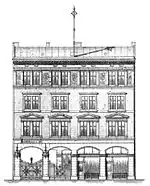Market halls in Berlin
By the year 1900, there were 14 market halls (or market houses) in Berlin.
| Name | Location | Built (date) | Sales area (in m²) / Number of stands | Remarks | Image |
|---|---|---|---|---|---|
| I, Zentralmarkthalle Berlin (I and II) | Berlin-Mitte, on both sides of Kaiser-Wilhelm-Straße (now Karl-Liebknecht-Straße) near Alexanderplatz | 1884–1886 and –1893 | 16.079/1336 13.281/776 |
The Central Market Hall I (as it was first called) was the first shopping center built according to the municipal building program. It had ice-cold storage rooms in the cellar area and its own railway connection to deliver goods. Until 1893, the extension of the central market hall was built on the opposite side of the street (Central Market Hall Ia or II). The Central Market Hall parts survived the First World War and the economic crisis to a large extent without damage, only in 1944 it was ruined. The Hall I, rebuilt in need of help, helped provide the East Berlin population. Hall Ia was dismantled. In the 1960s the first market hall was also destroyed. Some parts were integrated into a new building at the same place. | 
|
| II, Lindenhalle | Friedrichstadt, Berlin-Mitte, Lindenstraße 97/98 / Friedrichstraße 18 | 1884–1886 | 9114/746 | This market hall is located north of the Mehringplatz and has access from the Friedrichstraße and the Lindenstraße. All buildings along with the market hall fell into ruins at the end of the Second World War. While the residential buildings were replaced by new ones, the market hall was only rebuilt in 1962 and 1965 in its original form but with new materials. Until 2010 it served as the Berlin Flower Market. |  |
| III, Zimmerhalle | Friedrichstadt, Berlin-Mitte, Zimmerstraße 90/91 | 1884–1886 | 4843/409 | In 1910, it was closed down as a market place due to a decline in the number of retailers and leased to the catering firm Hoffmann & Retschlag. In 1942, the former harket hall also served as an internment station for arrested jews. After 1945, the building was converted into a business building. |  |
| IV | Dorotheenstadt, Berlin-Mitte, Reichstagufer corner of Dorotheenstraße | 1884–1886 | 3778/364 | The hall had a tunnel entrance to neighboring buildings. It was closed as a market hall in 1913. Parts were integrated into the new post office building at the same place. |  |
| V | Berlin-Tiergarten, Magdeburger Platz | 1886–1887 | 2538/231 | In the Second World War, the hall was damaged and finally dismantled in 1956. | |
| VI, Ackerhalle |
Berlin-Mitte, Invalidenstraße corner of Ackerstraße | 1886–1888 | 3546/344 | 
| |
| VII | Berlin-Kreuzberg, Dresdner Straße / Legiendamm | 1887–1888 | 4700/410 |  | |
| VIII | Berlin-Friedrichshain, Andreasstraße / Krautstraße | 1886–1. Mai 1888 | 5070/532 | ||
| IX, Eisenbahnhalle „Markthalle Neun |
Berlin-Kreuzberg, Pücklerstraße 34 / Eisenbahnstraße 42/43 | ?–1891 | 3296/300 |  | |
| X, Arminiushalle from 2010 Zunfthalle, now again Arminiushalle |
Berlin-Moabit, Arminiusstraße/Bremer Straße/Bugenhagenstraße/Jonasstraße | 1890–1891 | 4810/425 | The only one-storey market hall, also known as the Moabiter Hall , has been without any major interruptions since its opening.[1] |  More pictures More pictures |
| XI, Marheinekehalle | Berlin-Kreuzberg, Zossener Straße / Bergmannstraße | 1891–15. März 1892[2] | 2808/278 | Although severely damaged during the Second World War, in the summer of 1945, a new market activity began in the cellar. The upper surface served as a depot of a rubble railway until 1950.[3] |   |
| XII | Berlin-Gesundbrunnen, Grüntaler Straße / Badstraße 16a | 1890–1892 | 4198/273 | After a dramatic decline in the number of retailers (below 50), and due to inefficiency, the Berlin administration closed the hall in 1898.[4] |  |
| XIII | Berlin-Prenzlauer Berg, main engrance Wörther Straße 45 | 1890–1892 | 5095/393 | The indoor market was surrounded by Franseckystraße (north), Treskowstraße (east), Wörtherstraße (south) and Schönhauser Allee (west). After the number of leased market stalls had declined to around 100 by 1910, market hall was closed.[4] |  |
| XIV | Berlin-Gesundbrunnen, Dalldorfer Straße 21/22 (from 1919 Schönwalder Straße 19) east of the Wedding-Platz | 1890–1892 | 4057/352 | In 1910 this market hall is listed in the address book on Dalldorfer Straße, owned by the City of Berlin. |  |
References
- Homepage of Zunfthalle Arminiusmarkthalle
- Geschichte, Homepage of Marheineke-Markthalle, retrieved on 8 March 2016
- Angela M. Arnold, Gabriele von Griesheim: Trümmer, Bahnen und Bezirke. Eigenverlag, Berlin 2002, ISBN 3-00-009839-9, S. 117ff.
- Uwe Spiekermann: Basis der Konsumgesellschaft. Entstehung und Entwicklung des modernen Kleinhandels in Deutschland 1850–1914 (= Schriftenreihe zur Zeitschrift für Unternehmensgeschichte. Bd. 3). C. H. Beck, München 1999, ISBN 3-406-44874-7, S. 180/181, Google Books, retrieved on February 11, 2011
This article is issued from Wikipedia. The text is licensed under Creative Commons - Attribution - Sharealike. Additional terms may apply for the media files.